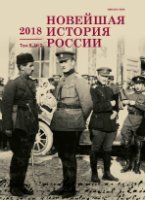Какую армию следует кормить во время Гражданской войны? (отношение населения Архангельской губернии к белым и красным)
Which Army Should the Population Feed during the Civil War? (The Attitude of the Population of the Arkhangelsk Province to the Whites and the Reds)
Author(s): Tatyana Igorevna TroshinaSubject(s): Agriculture, Military history, Pre-WW I & WW I (1900 -1919)
Published by: Издательство Исторического факультета СПбГУ
Keywords: Northern Russia; Revolution; 1917; Civil War; Non-belligerent Population; Self-defense; Combatants; Terror;
Summary/Abstract: In this article, on the basis of numerous archival documents and unpublished memoirs, a situation is shown in which the “non-belligerent” population of the Arkhangelsk province turned out to be. Their settlements during the civil war passed from one army to another, and both these armies were perceived by the population as “strangers”. The European North of Russia is a vast but sparsely populated area with a poorly regulated transport system. This created difficulties for the two opposing armies (White and Red) both in terms of insufficient mobilization resources, and in relation to providing armies. The local population engaged in crafts, went to work in cities. These opportunities were lost during the war. At the same time, the own agriculture did not provide even the population itself, and in the conditions of widespread military operations it was necessary to provide the soldiers with food and transportation. The ideology was an important part of the armed civil confrontation, therefore neither of these armies used rigid measures of coercion against the local population. Moreover, it was in the interests of the armies to help the population, which was primarily practiced by the Whites. At the same time, the fighting that was conducted by small mobile detachments did not allow timely supply of soldiers with food, warm clothes. All this was requisitioned from peasants and residents of small towns. The population, especially remote and small villages, feared such “raids” of soldiers. It created “self-defense units”, which gave a special flavor to the civil war. The population could not provide food for their “partisans”, and they entered the service in the army that controlled their village. With the retreat or offensive of the army, such “guerrillas” went into the woods and poured into another army that occupied their villages. The article focuses on the relationship between the non-belligerent population and the soldiers who came to their land, examines the forms of adaptation of the population to new living conditions.
Journal: Новейшая история России
- Issue Year: 8/2018
- Issue No: 23
- Page Range: 469-486
- Page Count: 18
- Language: Russian

